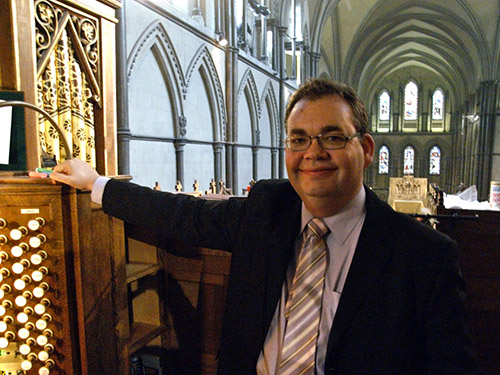

  |
|
|
||||||||||||||||||||||
|
FMS FEATURE... November 14, 2014 Pipe Organ Has Starring Role in Interstellar Zimmer records score in London's Temple Church by Jon Burlingame  London's Temple Church music director Roger Sayer But rarely, if ever, has a church organ figured so prominently in a major-studio film score as it does in composer Hans Zimmer's music for Interstellar, Christopher Nolan's new science-fiction epic. It was director Nolan's idea, Zimmer confesses, but the specific instrument to use was Zimmer's choice: the 1926 four-manual Harrison & Harrison organ in London's Temple Church, built in the 12th century by the Knights Templar (the order that figures prominently in The Da Vinci Code, a film Zimmer scored in 2003). Zimmer composed the score in his Santa Monica, Calif., studio using samples that originated with the organ in England's Salisbury Cathedral – but, as Temple Church music director Roger Sayer points out, "no matter how good the sampling was, it's still electronic. Hans wanted the feeling of a living, breathing instrument." And the real thing, Sayer said, "was as good, if not better, than he was hoping for." At its most powerful moments, the organ will shake theaters playing Interstellar. ("Excellent," says Zimmer.) "I was so pleased about that," says Sayer by phone from London. "This organ has got body and bass. We have three 32-foot-length pipes [which play the deepest tones] and if you combine those with the 16-foot stops, it's amazing. It shakes the church, too, not just the cinema." But it would be a mistake to think that the pipe organ only signals the big moments in Nolan's film. "It has the most simple, innocent sounds, and yet it has that sort of heroic, hymn-like sound and style which I think conjures up many emotions of joy and sadness as well," says Sayer. "The organ is basically an orchestra in a box," he adds. "A single sound can be the most beautiful thing, if it's voiced right and it has the right tone. Every stop you choose has a beautiful sound; it's just a matter of which one suits the occasion. Some of the sounds are really beguiling, really attractive, really soulful. One should never forget that the organ isn't just about bombast and decibels. It's about beauty and elegance." All of the organ parts in Interstellar were recorded in five sessions over eight days in late May. And while Zimmer's strings were also recorded in the Temple Church (a quartet at one end, the larger string section at the other, creating a dialogue effect a la Vaughan Williams' "Fantasia on a Theme by Thomas Tallis"), those recordings were done separately. Nolan, Sayer reports, was present for nearly all the recordings, and "he was enthusiastic as Hans was. It was basically a work in progress, experimenting – 'Here's a sound, do you like it?' 'Try this one, is this one better?'" Nolan was even present at one session where Zimmer was absent. It was for the music associated with Cooper (Matthew McConaughey) and his daughter Murph (Mackenzie Foy, later Jessica Chastain). "The theme runs through the film, and Nolan knew that this was most important, that we had to get the right sound. At the end, at its most poignant, it's pretty much just the organ on its own." Sayer, who has seen the film, was surprised and pleased with the part that the Temple Church organ plays in the final score. "It was fantastic," he says. "Of course I recognized it all, but how it was paced was amazing. The organ is implied at the beginning, nothing too in-your-face, but as things become more intense and emotional, the organ really seems to carry the burden. It's thrilling, really." Read about composer Hans Zimmer's long and fascinating Interstellar odyssey here. ©2014 Jon Burlingame |
Search
Past Features
Feature Archives
|